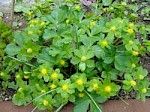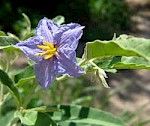I'm busy, detail oriented, cost conscious and highly selective as to whom works in and/or around my home. This is a service based company that actually provides superior service. Don't waste anymore time... call them. ~ a satisfied customer for three years.
Arizona Weed Control Service
Arizona Broadleaf Weed Control
As their name suggests, broadleaf weeds have broader leaves than grassy weeds, and you can use the shape and surface details of the leaves to identify which type of plants you have growing on your landscape.
Due to their size, broadleaf weeds are often known to be hardier than grassy varieties, which means that you must be aggressive when it comes to their control. Your Arizona weed control service will begin treatment early in the season, before you ever see a plant shoot up. However, you can use this information to identify suspected broadleaf weeds on your property so that you can seek the proper methods of treatment.
Purslane
 The U.S. Department of Agriculture has designated purslane as a noxious weed due to its prolific ability to spread seeds. You can identify this weed by its thick, fleshy leaves and yellow flowers.
The U.S. Department of Agriculture has designated purslane as a noxious weed due to its prolific ability to spread seeds. You can identify this weed by its thick, fleshy leaves and yellow flowers.
Mallow
In Arizona’s mild climate, mallow starts showing up in November or December in neglected areas. Mallow spreads quickly, has deep roots, and grow fast. It has geranium-like leaves with 5 or 7 lobes.
[photo]
Giant Hogweed
Hogweed needs to be eliminated immediately - it produces a toxic sap that can give you third-degree burns and lead to blindness.
The plants are large weeds with thick red and green stems and topped with white flowers. Plants can reach up to 14 feet in height.
[photo]
Globe Camomile
Globe camomile is an invasive weed that is originally from South Africa. It has long stalks with round, yellow flower heads and deeply lobed leaves. It has created a huge problem along the I-17 in Phoenix.
Sahara Mustard
This weed is a fast-growing, noxious weed that steals moisture and light from shrubs and plants and has been known to overrun 75% of our beautiful wildflower areas. It is an annual broadleaf with flower starks that can reach 3 feet in height. The flowers are small and a dull yellow color, appearing from February to April.
Goosefoot
Goosefoot is a common annual plant that can sometimes be toxic to grazing animals and desirable crops. The leaves on a mature goosefoot plant are dark green and shaped like a rounded triangle. The lower surface of the leaves may have a white powdery coating.
Pigweed
Pigweed plants can reach heights of up to six-feet if it is allowed to grow uncontrolled. Depending upon the species, pigweed leaves may be smooth, or they may have a covering of fine hairs. The leaves are oval-shaped with the widest part near the stalk, and the edges are slightly wavy.
Puncturevine
Puncturevine is one weed that you never want on your property. It's considered to be one of the nastiest weeds because it drops spiny seed burs that injure animals and humans are sharp enough to pierce through leather. This is a carpet growing plant with leaves formed of three to seven pairs of leaflets.
London Rocket
This weed starts out as small rosettes growing on the ground and eventually matures into a plant that can be up to two-feet tall with long flowering stems. The plant is a winter annual, which means that it begins to grow before the cold season is over and may begin to flower as early as January.
Bur Clover
Bur clover leaves are divided into three leaflets with rounded edges. Once mature, you can easily identify this weed by the irritating burs it drops on your property.
Cheeseweed
Cheeseweed is another winter annual that has potential to be toxic to wildlife. You can spot this weed by its wide and hairy leaves. You can also see small white or pale pink flowers blooming at any time during the growing season.
Tumbleweed
Tumbleweed, or Russian thistle, looks a lot like the skeleton of a shrub. These bushy plants are capable of growing quite large, and they attract pests and wildlife such as mice.
Silver Nightshade
 The beautiful purple to blue flowers that grow on this weed may have you admiring its beauty, yet the prickly stems let you know that you should not be fooled. Silver nightshade can be toxic to humans and cattle and must be removed from your property.
The beautiful purple to blue flowers that grow on this weed may have you admiring its beauty, yet the prickly stems let you know that you should not be fooled. Silver nightshade can be toxic to humans and cattle and must be removed from your property.
Prostrate Spurges
Prostrate spurge grows later in the summer season. It's a mat-forming annual, and the leaves have red blotches. If you break the stem, you will see a white, latex materials seeping out much like you would on a dandelion.
As you inspect your property for weeds, keep in mind that these are just a few of the most common broadleaf varieties that you may find in Arizona. Your Arizona weed control service will always make sure they know which weed they are dealing with before applying a treatment to protect the desired plants and ensure that the spray is effective.

